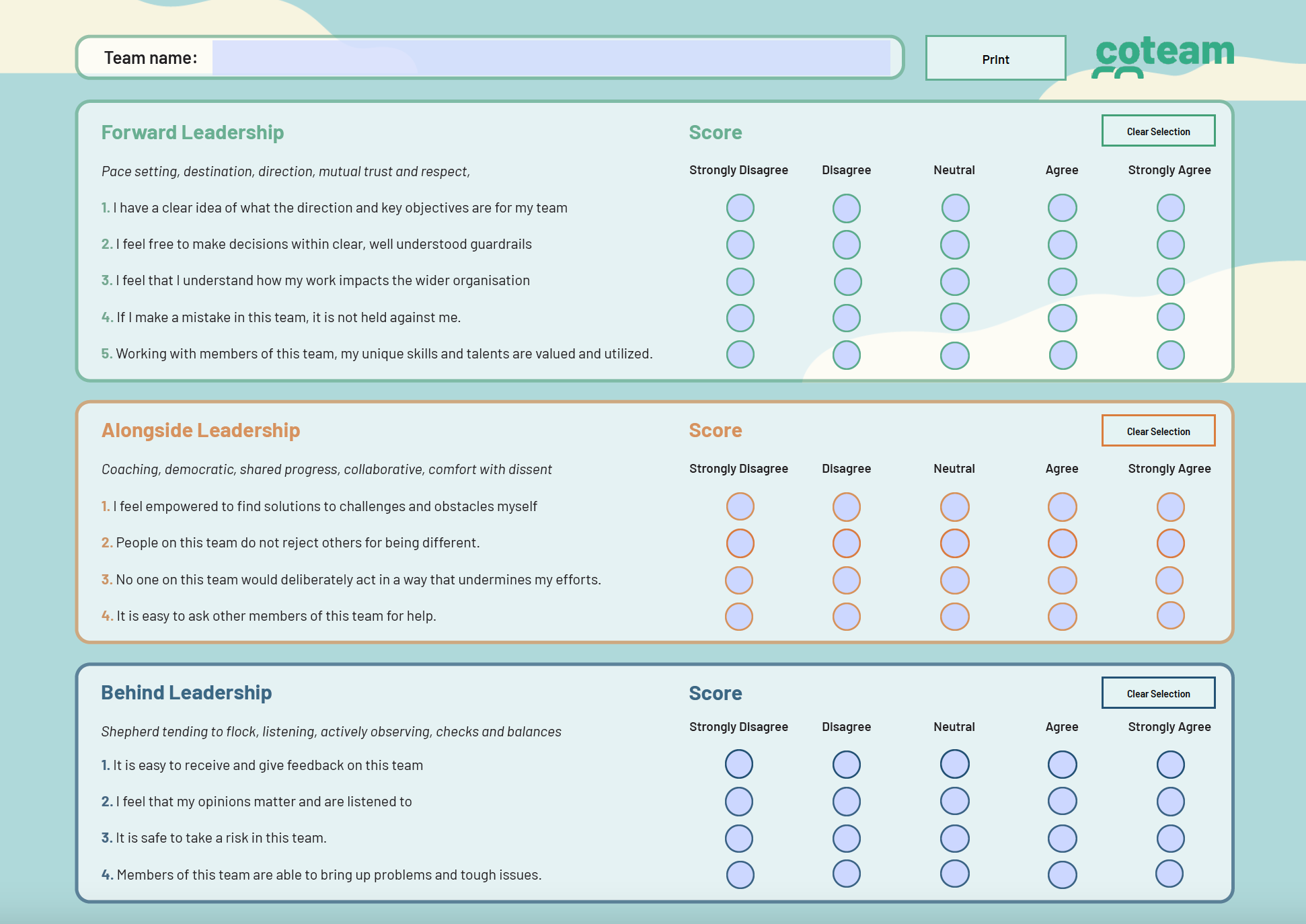5 Ways to Build Psychological Safety (and a FREE team questionnaire)
When Amy Edmondson first coined the term Psychological Safety back in 1999, the world was in a remarkedly different place. Yet over two decades later, its relevance is gaining even more traction. For all the volatility, uncertainty, complexity and ambiguity of the world we live in now, adaptiveness and ability to embrace change are the new cornerstones of leadership. It’s impossible to know all of the answers, and as organisations reorient themselves to see management as a service function, trust and dependability within teams become paramount importance.
If you are managing a team, there’s no doubt that the concept of psychological safety has become almost a mandate. As if it were a checkbox that can be ticked. But what does it even mean? And can it be measured? In this article we’ll help you identify how psychologically safe your team is feeling and identify five key steps you can take to foster it within your organisation.
But first, a definition:
“ “Psychological safety means an absence of interpersonal fear. When psychological safety is present, people are able to speak up with work-relevant content.”
Using a typically data-drive approach, several years ago Google embarked on Project Aristotle, trying to ascertain the core foundations of effective teams. Psychological Safety resoundingly placed as the first priority. Far from being fluffy, they saw that sales teams who were psychologically safe outperformed teams who were not by an astonishing 36 percent.
There are some common warning signs when a team needs to improve psychological safety:
Fear of asking for or giving constructive feedback
Hesitance around expressing divergent ideas and asking “silly” questions
Tip 1 – Download and complete our Psychological Safety questionnaire
To help you quantify the level of safety within your team, we have put together a useful survey. Before we go about thinking how we can improve things, it’s important we audit where we are at. Distribute this around your team, and ask each member to complete it individually. Tally the scores, and you have already completed the first step in improving team trust.
Becoming a FABulous Leader
At Coteam, we are hyper-aware that the role of management has shifted, which has led us to develop the FAB model, identifying three different leadership “modes” which are all as important as one another
FORWARD Leadership “Mode”
The ability to set the direction and communicate clearly. This is the most “traditionally recognised” form of management, but effective FORWARD leaders can tell compelling stories and create a sense of purpose for their team.
ALONGSIDE Leadership “Mode”
What would traditionally be referred to as coaching, an Alongside leader is able to sit beside their team and help them solve problems. Far from just giving answers, an effective ALONGSIDE leader will guide, without telling. For this to work, the team needs to be comfortable with dissent. This is the foundation to create both trust and accountability.
BEHIND Leadership “Mode”
Often the most overlooked yet powerful modes of leadership, the ability to “get out of the way” is a foundational tool in an effective managers arsenal. But an effective BEHIND leader isn’t about going to golf, it’s about practising active observation and providing quality feedback where it is needed.
It’s important to note that these three leadership “modes” don’t exist independently from one another, and any given situation may require a manager to inadvertently switch between the three. But with the topic of Psychological Safety at hand, having completed the questionnaire, lets explore some more ways you can build this in your team.
Forward
If you’ve noticed your team has scored particularly low in the FORWARD part of the questionnaire, it could be a sign that you need to practice your skills in providing clarity and setting direction.
Tip 2 – Provide Clarity
A team should be united around the vision of where they are heading, and the role they play in this. Help your team understand this by engaging them with clear direction. Emphasise purpose. Try to identify what the teams outcomes are, rather than specific outputs, and use time in meetings to ensure these are clearly understood by everyone.
It’s also crucially important to make sure you don’t command more than is necessary. Doing so can pose the risk of creating an environment where people don’t feel they can be trusted to draw their own lines of conclusion. Underline the importance of everyones voice.
Alongside
If you notice the team has scored particularly low in the ALONGSIDE part of the questionnaire, it’s time to put to practice your coaching skills, and address fear around failure within the team.
Tip 3 – Guide, do not tell
Trust can take a lifetime to build, and a second to destroy. Teach a man to fish and you’ll feed him for a lifetime. As a manager, how can you focus on individual strengths and help team members to discover answers for themselves. Use your own experiences as stimulus and ask open questions as provocation to create an environment that promotes learning.
It’s been proven many times that autonomy is one of the greatest drivers of human motivation, so consider your role as a manager in how you can promote this, with appropriate guardrails.
Tip 4 – Embrace failure
A psychologically safe team will view failure as an opportunity to learn. Avoid blaming one another if things go wrong, but rather collectively use the opportunity for collective learning. By being relentless self-aware of this yourself, you can lead by example, then demand the same from your team members.
Encourage team members to ask for help and discourage them from rejecting ideas because they are different.
Behind
If you notice the team has scored particularly low in the BELOW part of the questionnaire, then your first step is to try to observe how the team is acting and try to understand the root cause of potential problems.
Tip 5 – Create a feedback culture
In an effort to promote more self-awareness, team members need to feel comfortable giving and receiving feedback to one another. Once again, as a manager it is your responsibility to role model this.
Try to base feedback on facts and use data where possible to support the argument. Avoid bringing emotion in unnecessarily. The SBI feedback model is particularly useful for teams starting to promote a feedback culture. Like anything, giving feedback properly takes practice, but most importantly, try and deal with things as they come up. Leaving them boil below the surface is only going to destroy the trust in a team
In conclusion…
Remember, that whilst psychological safety is admittedly one of the biggest contributors to team performance, it’s not the only one. If you are interested in exploring others, please check out our Team Effectiveness Audit.
Of if you are interested in getting everyone on the same page, why not get in touch and find out more about our Psychological Safety Masterclass.




